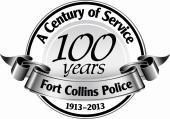
To Protect and Serve: Transportation and Communication Changes Aid Police Efforts
Part 3 in a series of articles chronicling the history of Fort Collins Police Services
As the saying goes, change is the constant, and that is no different with the evolution of Fort Collins Police Services.
A look backwards reveals police transportation has evolved: the first twin-engine Indian motorcycle was purchased in 1914; the first car, a 1924 Ford Runabout, which was totaled the very first week on the road in a high speed chase at 40 miles an hour. A Harley Davidson three-wheeler was purchased in the '30s and, with more vehicles driven by citizens, the Police Department followed suit, adding its own vehicles.
Police cars in the 1950s were unmarked, carrying one red spotlight on the right side of the car, a white one on the left, and a siren in the grill. This configuration required the officer to reach across the car to turn on the red light in order to stop someone. By 1955, three cars were in use by the Police Department.
In 1963, Chief Clinton Smith convinced City Council to buy a new fleet of cars, visibly marking them and adding round lights and a siren on the top. Policy also evolved with the need and, in 1974, the one-to-one car plan was implemented assigning one car to each officer to be used on and off duty. Allowing officers to take the cars home and park them outside their residences gave the appearance of more police officers in the city. This plan, which is still in existence today, allows officers to respond to calls while off duty, if necessary, and saves significant time as they respond to emergency call, where every minute counts. An added plus of this plan is that the cars lasted longer because the officers perform regular maintenance, and the vehicles are not being driven 24 hours per day.
Equipment in the cars also became more elaborate over the years, with long rifles and shotguns carried in the trunk of the cars. Special seats, CD players and larger engines became standard issue. Four-wheel-drive vehicles were added for driving in inclement weather.
This year, Fort Collins patrol cars are returning to a classic look as older cars are retired. Twenty-seven Ford Explorer Police Interceptors were ordered; two are in service now, and the rest will be delivered in July. The Interceptors sport a classic black and white theme, carrying the image of the police badge on the front doors and "Fort Collins Police" lettering on both sides.
In addition to vehicles, many would agree that communication has seen the greatest changes in equipment and technology over the years.
The earliest form of communicating with officers in the field involved using red lights placed on several buildings around town. If a City operator was called, the light was activated and an officer who saw it would go to the nearest call box to get further instructions. Those lights were used until the '50s. In 1952, one-way radios were placed in the cars, but officers still had to go to a red call box to respond. The first two-way radios came into operation in 1955 and, in the late '60s, handheld units became available.
A big jump came with the advent and use of computers. Fort Collins became one of the first cities in the nation to switch to a computer-aided dispatch system, and in 1985, Rudimentary Mobile Data Terminals (MDT) were installed in the cars. Radios were still used for emergency or multiple office or agency calls, while all routine calls were communicated on the computers. Today, all vehicles are equipped with up-to-date laptop computers.
Initial pagers in the 1980s would only beep when someone was trying to reach you, requiring the officer to call dispatch for more information. The mobile Motorola radios weighed five pounds, and required batteries. In the 1990s pagers became smaller and more sophisticated, allowing text messages to be relayed from dispatchers or from another employee. Around 1998, cell phones were issued, and executive staff and lieutenants used a Blackberry. In recent years, those were replaced with smartphones.
As equipment and procedures changed, so did the science of criminal investigation. In 1987 DNA results were first used in a case in England. By 1995, DNA was being used locally, but it was a cumbersome process, sending samples to the FBI and waiting six months for results due to the tremendous backlog. Today DNA analysis is can be accomplished within 24 hours, and much of it goes to the Colorado Bureau of Investigation (CBI).